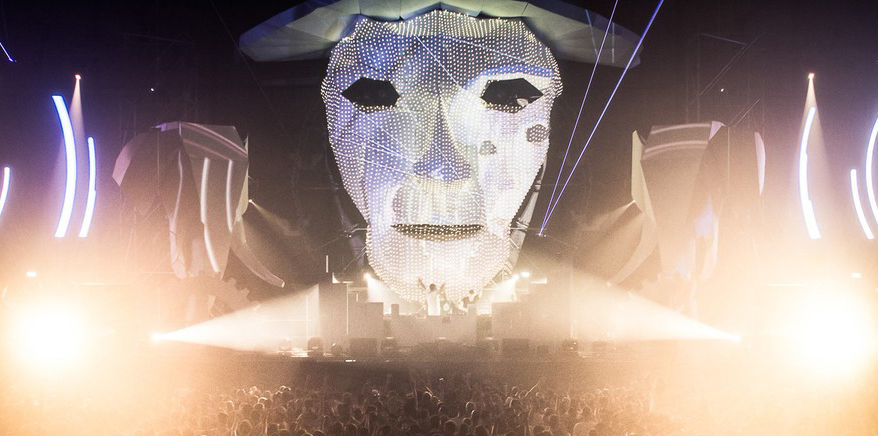Mr. Mask was a triumph of teamwork. This is by far the largest project we’ve worked on so far, consisting of a 3-story tall polygonal mask covered in over 5000 LEDs. In addition to that, the team from 4youreye added video mapping content to make this already amazing installation just that much more special. Teams of set builders, riggers, lasers, lighting, projection mapping and LED technicians managed to pull off a monumental achievement for a phenomenal event. We were in charge of the LED installation that overlaid the massive mask made of hardened cardboard. We painstakingly attached 80 lines of pixel string to the structure, creating a large screen for us to play with.

Technical Details
The Mr. Mask installation was by far the most complicated project we’ve ever undertaken. In total, the structure contained 5600 pixels, aligned in 80 columns. Due do the 3D nature of the sculpture, the individual pixels were not aligned and each column had variable length. This posed a challenge from an engineering standpoint. The power layout became quite tricky using such long lengths of pixel string (up to 15m). Here’s a brief rundown of the challenges we faced and how we solved them.
Power layout
The WS2812b pixels that we used require 5V power, which means that they’re very efficient but physical distance quickly becomes a problem. Each pixel consumes roughly 60mA, which translates to rougly 336A for the entire structure
0.06A x 5600 = 336A
We decided to use 12 x 5V 30A switching power supplies, which gave us a comfortable overhead with 360A of power. Luckily, because the mask was built over layher scaffolding, we could attach the power supplies where we needed them: spread out evenly throughout the structure. We powered the LEDs at the top and bottom of each line, as well as adding 2 horizontal power busses across the entire mask.
Controller
We decided to use a Beaglebone Black running custom software as a controller for the LEDs. We had 14 outputs from the Beaglebone, each controlling roughly 400 pixels.The pixel string had a pitch of 20cm, which is quite far apart but at this scale it is more than adequate. The controller was then connected to Front Of House via ethernet connection. At Front Of House, we had custom written visualization software that sent the LED information to the controller. We used an APC40 as our interface.
Hardware:
Beaglebone Black
12 x 5v 30A switching power supply
1.1 km x LED string with 20cm pitch
Ethernet switch
MacBook Pro
APC40 MIDI controller
![]()
